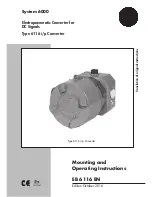
12
IMR02E20-E1
4. WIRING
This chapter describes wiring cautions, terminal configuration and connections.
4.1 Wiring Cautions
To avoid noise induction, keep communication signal wire away from instrument power line, load
lines and power lines of other electric equipment.
If there is electrical noise in the vicinity of the instrument that could affect operation, use a noise filter.
Shorten the distance between the twisted power supply wire pitches to achieve the most effective
noise reduction.
Always install the noise filter on a grounded panel. Minimize the wiring distance between the noise
filter output and the instrument power supply terminals to achieve the most effective noise reduction.
Do not connect fuses or switches to the noise filter output wiring as this will reduce the
effectiveness of the noise filter.
Power supply wiring must be twisted and have a low voltage drop.
For an instrument with 24 V power supply input, supply power from a “SELV” circuit defined as
IEC 60950-1.
A suitable power supply should be considered in end-use equipment. The power supply must be in
compliance with a limited-energy circuits (maximum available current of 5.6 A).
Supply the power to only one of the joined modules or COM-ML. When power is supplied to any
one of the joined modules or COM-ML, all of the joined modules and COM-ML will receive power.
Select the power capacity which is appropriate for the total power consumption of all joined
modules (include COM-ML) and the initial current surge when the power is turned on.
Power consumption (at maximum load): 120 mA max. (at 24 V DC)
Rush current: 12 A or less
When connecting the wiring to the power supply terminals on the base, use the specified solderless
terminals. Only these specified solderless terminals can be used due to the insulation between the
terminals.
Screw Size:
M3
7 (with 5.8
5.8 square washer)
Recommended tightening torque:
0.4
N
・
m (4 kgf
・
cm)
Applicable wire: Solid/twisted wire of 0.25 to 1.65 mm
2
Specified solderless terminal:
Manufactured
by
J.S.T MFG CO., LTD.
Circular terminal with isolation
V1.25
MS3
Make sure that during field wiring parts of conductors cannot come into contact with adjacent conductive parts.
When tightening a screw of the instrument, make sure to fit
the screwdriver properly into the screw head mounted tilted
or flat as shown in the right figure. Tightening the screw
with excessive torque may damage the screw thread.
(Only function modules)
5.5 MAX
3.2 MIN
5.6 mm
9.0 mm
5.0
To prevent electric shock or instrument failure, do not turn on the power until all
wiring is completed. Make sure that the wiring is correct before applying power
to the instrument.
Tilted terminal
Flat terminal
















































